In the months after 9/11, Cheney, Rumsfeld and their teams launched several major initiatives aimed at ensuring that no bureaucracy would stand in the way of their plans for the unchecked use of the darkest US forces. Cheney wanted to disabuse the CIA of the idea that it had any kind of independence. Rather than having the Agency serve as the president’s premier fact-checking and intelligence resource, the CIA’s new job would be to reinforce predetermined policy. Cheney wanted to gut the interagency reviews of proposed lethal actions that were standard under Clinton. Soon after 9/11, the White House convened a group of senior administration lawyers whose job it would be to legally justify torture, kidnapping and assassination. The group secretly dubbed itself the “War Council” and was led by David Addington, Cheney’s counsel and longtime adviser who had worked with him on the “minority report” defending Iran-Contra. It also included White House counsel Alberto Gonzales and his deputy, Tim Flanigan; the Pentagon’s general counsel, William Haynes; and Deputy Assistant Attorney General John Yoo. The War Council explicitly excluded the State Department’s general counsel and other military and Justice Department lawyers who had historically been included in reviewing legal structures for combating terrorism. This point was clear: this group was to develop legal justification for tactics in a covert dirty war, not to independently assess their legality.
To fight its global war, the White House made extensive use of the tactics Cheney had long advocated. Central to its “dark side” campaign would be the use of presidential findings that, by their nature, would greatly limit any effective congressional oversight. According to the National Security Act of 1947, the president is required to issue a finding before undertaking a covert action. The law states that the action must comply with US law and the Constitution. The presidential finding signed by Bush on September 17, 2001, was used to create a highly classified, secret program code-named Greystone. GST, as it was referred to in internal documents, would be an umbrella under which many of the most clandestine and legally questionable activities would be authorized and conducted in the early days of the Global War on Terror (GWOT). It relied on the administration’s interpretation of the AUMF passed by Congress, which declared any al Qaeda suspect anywhere in the world a legitimate target. In effect, the presidential finding declared all covert actions to be preauthorized and legal, which critics said violated the spirit of the National Security Act. Under GST, a series of compartmentalized programs were created that, together, effectively formed a global assassination and kidnap operation. Authority for targeted kills was radically streamlined. Such operations no longer needed direct presidential approval on a case-by-case basis. Black, the head of the Counterterrorism Center, could now directly order hits.
The day Bush signed the memorandum of notification, which among other initiatives, authorized a High Value Detainee program, CTC personnel and “selected foreign counterparts” were briefed on it in Washington, DC. “Cofer [Black] presented a new Presidential authorization that broadened our options for dealing with terrorist targets—one of the few times such a thing had happened since the CIA was officially banned from carrying out assassinations in 1976,” recalled Tyler Drumheller, the former head of CIA clandestine ops in Europe. “It was clear that the Administration saw this as a war that would largely be fought by intelligence assets. This required a new way of operating.” John Rizzo, a veteran CIA attorney who helped draft the authorization, later said, “I had never in my experience been part of or ever seen a presidential authorization as far-reaching and as aggressive in scope. It was simply extraordinary.”
GST was also the vehicle for snatch operations, known as extraordinary renditions. Under GST, the CIA began coordinating with intelligence agencies in various countries to establish “Status of Forces” agreements to create secret prisons where detainees could be held, interrogated and kept away from the Red Cross, the US Congress and anything vaguely resembling a justice system. These agreements not only gave immunity to US government personnel, but to private contractors as well. The administration did not want to put terror suspects on trial, “because they would get lawyered up,” said Jose Rodriguez, who at the time ran the CIA’s Directorate of Operations, which was responsible for all of the “action” run by the Agency. “[O]ur job, first and foremost, is to obtain information.” To obtain that information, authorization was given to interrogators to use ghoulish, at times medieval, techniques on detainees, many of which were developed by studying the torture tactics of America’s enemies. The War Council lawyers issued a series of legal documents, later dubbed the “Torture Memos” by human rights and civil liberties organizations, that attempted to rationalize the tactics as necessary and something other than torture. “We needed to get everybody in government to put their big boy pants on and provide the authorities that we needed,” recalled Rodriguez, who, with Black, would become one of the key architects of the torture policy. “I had had a lot of experience in the Agency where we had been left to hold the bag. And I was not about to let that happen for the people that work for me.”
The CIA began secretly holding prisoners in Afghanistan on the edge of Bagram Airfield, which had been commandeered by US military forces. In the beginning, it was an ad hoc operation with prisoners stuffed into shipping containers. Eventually, it expanded to a handful of other discrete sites, among them an underground prison near the Kabul airport and an old brick factory north of Kabul. Doubling as a CIA substation, the factory became known as the “Salt Pit” and would be used to house prisoners, including those who had been snatched in other countries and brought to Afghanistan. CIA officials who worked on counterterrorism in the early days after 9/11 said that the idea for a network of secret prisons around the world was not initially a big-picture plan, but rather evolved as the scope of operations grew. The CIA had first looked into using naval vessels and remote islands—such as uninhabited islands dotting Lake Kariba in Zambia—as possible detention sites at which to interrogate suspected al Qaeda operatives. Eventually, the CIA would build up its own network of secret “black sites” in at least eight countries, including Thailand, Poland, Romania, Mauritania, Lithuania and Diego Garcia in the Indian Ocean. But in the beginning, lacking its own secret prisons, the Agency began funneling suspects to Egypt, Morocco and Jordan for interrogation. By using foreign intelligence services, prisoners could be freely tortured without any messy congressional inquiries.
In the early stages of the GST program, the Bush administration faced little obstruction from Congress. Democrats and Republicans alike gave tremendous latitude to the administration to prosecute its secret war. For its part, the White House at times refused to provide details of its covert operations to the relevant congressional oversight committees but met little protest for its reticence. The administration also unilaterally decided to reduce the elite Gang of Eight members of Congress to just four: the chairs and ranking members of the House and Senate intelligence committees. Those members are prohibited from discussing these briefings with anyone. In effect, it meant that Congress had no oversight of the GST program. And that was exactly how Cheney wanted it.
THE BUSH ADMINISTRATION did not create the CIA’s rendition program. It started under Clinton in the mid-1990s when he signed a presidential directive authorizing the CIA and US Special Operations Forces, in conjunction with the FBI, to snatch terror suspects from across the globe without the need to respect bilateral extradition agreements or international conventions. But the Clinton directive also allowed for these US officers to send terror suspects to Egypt, where, far removed from US law and due process, they could be interrogated by mukhabarat (secret police) agents not constrained by US prohibitions against torture. The program required direct authorization for each snatch operation. Under Clinton, more than seventy renditions were conducted. In some cases, US planes would land in countries and ferry their targets back to the United States for trial. Among these high-profile renditions conducted under Clinton were: Mir Aimal Kasi, a Pakistani national who had shot and killed two CIA employees outside the Agency’s headquarters in 1993 and was rendered from Pakistan in 1997; Ramzi Yousef, the mastermind of the 1993 World Trade Center bombing; Wali Khan Amin Shah, who plotted to blow up multiple US airlines on a single day in 1995; and Japanese Red Army member Tsutomu Shirosaki, who bombed the US Embassy in Jakarta in 1986 and was eventually snatched in 1996. All of these renditions involved court orders from US judges and ended in civilian trials. However, in cases where the United States wanted intelligence rather than justice, it would render them to third countries where they would have no legal rights. In 1998, the US Congress passed legislation declaring that it is “the policy of the United States not to expel, extradite, or otherwise effect the involuntary return of any person to a country in which there are substantial grounds for believing the person would be in danger of being subjected to torture, regardless of whether the person is physically present in the United States.” Bush’s post-9/11 presidential directives threw those concerns out the door, and the CIA intensified its use of what human rights advocates came to call “torture taxis.”
Читать дальше












